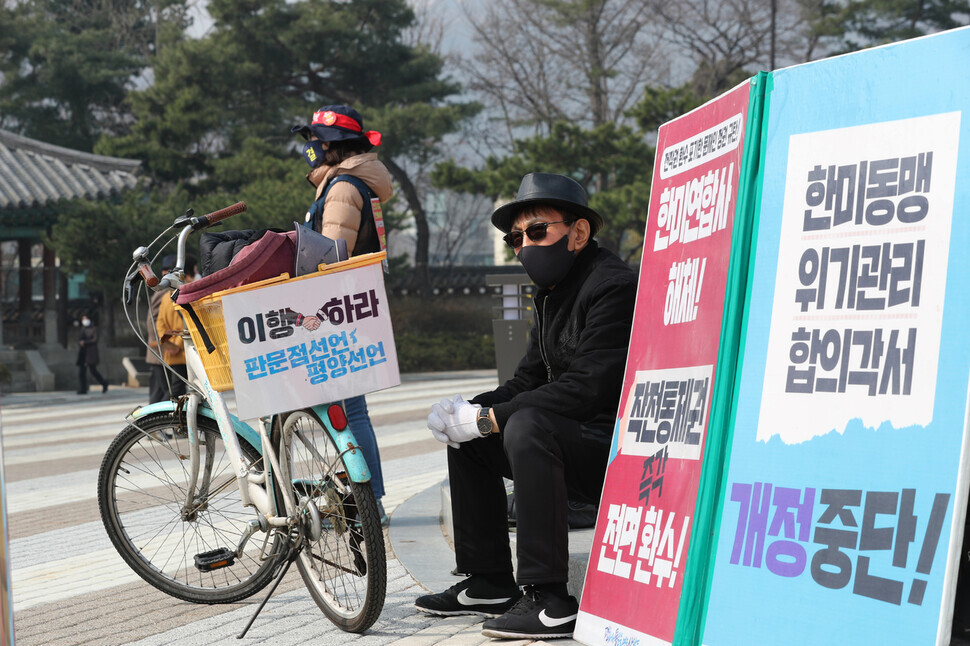hankyoreh
Links to other country sites 다른 나라 사이트 링크
[Photo essay] Why does US dictate terms of S. Korea-US alliance?

South Korea and the US updated their arrangement for splitting the cost of keeping US troops stationed in South Korea. While Article 5 of their Status of Forces Agreement (SOFA) states that the US is responsible for all costs pertaining to the operation and maintenance of US Forces Korea (USFK), the US and South Korea signed a special agreement in 1991 to divide those costs.
In contrast, South Korea doesn’t receive any compensation for the land or facilities it provides to USFK.
USFK has used South Korea’s financial contribution to build the future home of the Combined Forces Command in the US military base in Pyeongtaek; to construct an ammunition warehouse at the THAAD missile defense battery in Soseong Village, Seongju; to build a hanger at Osan Air Base from which planes are dispatched to the South China Sea and the Taiwan Strait, in an attempt to counter China; and even to repair aircraft based in Japan for decades.
There’s no justification in the two countries’ various agreements — SOFA, their mutual defense treaty, or their defense cost-sharing arrangement, called the Special Measures Agreement (SMA) — for spending South Korea’s contribution in those ways. But South Korea has no control over how the USFK spends its money.
US troops are stationed in more than 70 countries around the world, but South Korea and Japan are the only ones that cover part of the garrison cost. In the 11th SMA, South Korea agreed to raise its defense burden by 13.9% this year (to 1.18 trillion won, US$1.04 billion) and then to increase it at a rate equivalent to the increase in defense spending in the previous year through 2025.
Previously, South Korea’s cost-sharing contribution had been pegged to the rate of inflation. South Korea’s inflation last year was 0.5%; the total cost of maintaining USFK rose by 0.7%; and Japan’s cost-sharing contribution edged up 1.2% this year — while South Korea’s contribution was jacked up by the unprecedented rate of 13.9%.
Considering that South Korea’s defense budget has risen by an average annual rate of 7.4%, we’ll probably be paying about 1.5 trillion won (US$1.32 billion) in 2025.
By Chang Chul-kyu, senior staff writer
Please direct comments or questions to [english@hani.co.kr]

Editorial・opinion
![[Column] Season 2 of special prosecutor probe may be coming to Korea soon [Column] Season 2 of special prosecutor probe may be coming to Korea soon](https://flexible.img.hani.co.kr/flexible/normal/500/300/imgdb/original/2024/0426/3317141030699447.jpg) [Column] Season 2 of special prosecutor probe may be coming to Korea soon
[Column] Season 2 of special prosecutor probe may be coming to Korea soon![[Column] Park Geun-hye déjà vu in Yoon Suk-yeol [Column] Park Geun-hye déjà vu in Yoon Suk-yeol](https://flexible.img.hani.co.kr/flexible/normal/500/300/imgdb/original/2024/0424/651713945113788.jpg) [Column] Park Geun-hye déjà vu in Yoon Suk-yeol
[Column] Park Geun-hye déjà vu in Yoon Suk-yeol- [Editorial] New weight of N. Korea’s nuclear threats makes dialogue all the more urgent
- [Guest essay] The real reason Korea’s new right wants to dub Rhee a founding father
- [Column] ‘Choson’: Is it time we start referring to N. Korea in its own terms?
- [Editorial] Japan’s rewriting of history with Korea has gone too far
- [Column] The president’s questionable capacity for dialogue
- [Column] Are chaebol firms just pizza pies for families to divvy up as they please?
- [Column] Has Korea, too, crossed the Rubicon on China?
- [Correspondent’s column] In Japan’s alliance with US, echoes of its past alliances with UK
Most viewed articles
- 1After election rout, Yoon’s left with 3 choices for dealing with the opposition
- 2AI is catching up with humans at a ‘shocking’ rate
- 3South Korea officially an aged society just 17 years after becoming aging society
- 4Noting shared ‘values,’ Korea hints at passport-free travel with Japan
- 51 in 5 unwed Korean women want child-free life, study shows
- 6Is Japan about to snatch control of Line messenger from Korea’s Naver?
- 7Why Kim Jong-un is scrapping the term ‘Day of the Sun’ and toning down fanfare for predecessors
- 8Two factors that’ll decide if Korea’s economy keeps on its upward trend
- 9[Column] ‘Choson’: Is it time we start referring to N. Korea in its own terms?
- 10Korea’s 1.3% growth in Q1 signals ‘textbook’ return to growth, says government